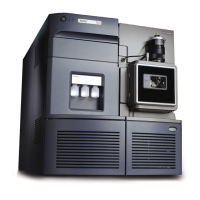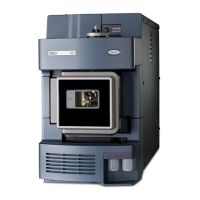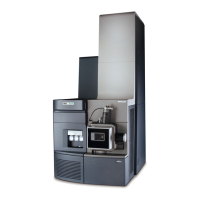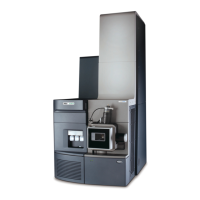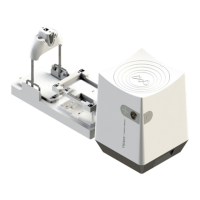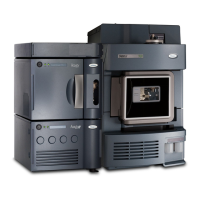Do you have a question about the Waters Xevo TQ MS and is the answer not in the manual?
Provides legal notice regarding copyright and reproduction rights.
Lists registered and unregistered trademarks associated with the product and company.
Details specific safety concerns and warnings related to the Xevo TQ MS instrument.
Information regarding compliance with Federal Communications Commission regulations.
Information regarding compliance with Canadian spectrum management regulations.
Guidance on safe placement and operation related to electrical power.
Instructions on consulting documentation for hazard symbols and actions.
Warning about impaired protection if equipment is used improperly.
Reference to Appendix A for comprehensive warning and caution advisories.
Explains various symbols used in the manual and their definitions.
Defines the intended audience and the overall purpose of the guide.
Describes the purpose and application of the Xevo TQ MS instrument.
Provides guidance on the calibration procedures for LC systems and mass spectrometers.
Details recommended procedures for running QC samples and managing data.
Specifies the instrument's classification according to ISM requirements.
Provides a general overview of the Waters Xevo TQ MS instrument.
Describes the different ionization techniques and source probes compatible with the instrument.
Details the IntelliStart Fluidics system, its components, and operation.
Explains the operation of the mass spectrometer's ion optics.
Details the available MS operating modes and their configurations.
Describes the various MS/MS operating modes, such as MRM and product ion scans.
Explains the function and operation of the instrument's leak sensors.
Describes the vacuum system components and their role in instrument operation.
Illustrates and identifies the connectors on the mass spectrometer's rear panel.
Step-by-step guide on how to power on and prepare the mass spectrometer for use.
Checks to confirm the instrument is in proper operating condition.
Explains the meaning of the operational status indicated by the instrument's LEDs.
Guidance on performing tuning and calibration procedures before instrument use.
Provides parameters for optimizing desolvation and sensitivity at high flow rates.
Instructions for setting up the IntelliStart Fluidics system, including reservoir installation.
Steps to restart the mass spectrometer's electronics when software fails or after an upgrade.
Guidelines on when to leave the instrument in Operate mode versus Standby mode.
Procedure for safely shutting down the mass spectrometer in an emergency situation.
Instructions for fitting and operating the ESI probe for Electrospray Ionization.
Guidance on fitting an ESI probe and corona pin for ESCi operation.
Details on installing and operating the APCI probe for Atmospheric Pressure Chemical Ionization.
Information on operating the optional APPI, APCI, or dual-mode APPI/APCI source.
Describes the NanoFlow ESI source, its components, and installation.
Lists periodic maintenance tasks to ensure optimum instrument performance.
Information on ordering and replacing spare parts for the instrument.
Guide to using Connections INSIGHT for device management and submitting support requests.
General safety considerations and handling precautions for performing maintenance.
Procedure to prepare the instrument before performing maintenance on the source.
Steps for removing and reinstalling the instrument's source enclosure.
Procedure for installing and removing the corona pin for specific operation modes.
Instructions for closing and opening the source isolation valve for maintenance.
Guidance on using the O-ring removal kit and handling O-rings and seals.
Instructions for cleaning the exterior surfaces of the mass spectrometer.
Procedure for inspecting and emptying the nitrogen exhaust trap bottle.
Steps for checking and maintaining the oil level in the Varian roughing pump.
Procedure for adding oil to the Varian roughing pump when the level is low.
Annual procedure for changing the roughing pump oil and oil mist filter.
Guidance on cleaning various components within the instrument's source.
Steps for removing, disassembling, and cleaning the sampling cone assembly.
Procedure for cleaning the extraction cone after other components have been cleaned.
Instructions for cleaning the ion block assembly if signal sensitivity issues persist.
Procedure for cleaning the source hexapole assembly when signal sensitivity is low.
Instructions for replacing the ESI probe tip and gasket due to blockage or damage.
Procedure for replacing the ESI probe's stainless steel sample capillary.
Procedure for cleaning the APCI probe tip when buffer buildup or weak signal is detected.
Instructions for replacing the APCI probe's sample capillary if blocked or damaged.
Guidance on cleaning or replacing the corona pin for APCI and ESCi modes.
Procedure for replacing the APCI probe heater if it fails to heat.
Procedure for replacing the ion block source heater if it fails to heat.
Instructions for replacing various seals in the source assembly to prevent solvent vapor leakage.
Instructions for annually replacing the instrument's air filter.
Steps for safely changing the UV lamp bulb in the APPI/APCI source.
Procedure for cleaning the magnesium fluoride lamp window for optimal photon transmission.
Instructions for replacing O-rings in the APPI lamp drive assembly annually.
Explains various warning symbols and their associated risks and precautions.
Highlights caution advisories related to instrument use that could damage it or compromise sample integrity.
General warnings applicable to all Waters instruments and devices regarding modifications.
Safety warnings and instructions related to replacing fuses in the instrument.
Lists electrical and handling symbols with their associated statements and meanings.
Explains common electrical symbols found on instruments and in manuals.
Defines common handling symbols found on packaging and labels.
Reference to a document for preventing contamination in the IntelliStart Fluidics system.
Table listing instrument components and their material exposed to solvents.
Lists common solvents used for mobile phases in reverse-phase LC/MS.
Diagram and explanation of the mass spectrometer's rear panel connectors.
Step-by-step guide for connecting the Varian oil-filled roughing pump.
Instructions for connecting the alternative Edwards oil-free roughing pump.
Procedure for connecting the instrument to a nitrogen gas supply.
Steps for connecting the argon gas supply to the collision cell.
Instructions for connecting the nitrogen exhaust line to the trap bottle and exhaust system.
Procedure for connecting the instrument's liquid waste line to a container.
Guidance on setting up and connecting the workstation to the mass spectrometer.
Steps for making Ethernet connections between the workstation and instrument.
Information on the instrument's rear panel connectors for input/output signals.
Instructions for connecting the instrument to a suitable electricity source.
Reference to a document for preventing contamination in the IntelliStart Fluidics system.
Diagram illustrating the plumbing layout of the IntelliStart Fluidics system.
Table detailing the specifications for replacement pipes used in the IntelliStart Fluidics system.
Provides legal notice regarding copyright and reproduction rights.
Lists registered and unregistered trademarks associated with the product and company.
Details specific safety concerns and warnings related to the Xevo TQ MS instrument.
Information regarding compliance with Federal Communications Commission regulations.
Information regarding compliance with Canadian spectrum management regulations.
Guidance on safe placement and operation related to electrical power.
Instructions on consulting documentation for hazard symbols and actions.
Warning about impaired protection if equipment is used improperly.
Reference to Appendix A for comprehensive warning and caution advisories.
Explains various symbols used in the manual and their definitions.
Defines the intended audience and the overall purpose of the guide.
Describes the purpose and application of the Xevo TQ MS instrument.
Provides guidance on the calibration procedures for LC systems and mass spectrometers.
Details recommended procedures for running QC samples and managing data.
Specifies the instrument's classification according to ISM requirements.
Provides a general overview of the Waters Xevo TQ MS instrument.
Describes the different ionization techniques and source probes compatible with the instrument.
Details the IntelliStart Fluidics system, its components, and operation.
Explains the operation of the mass spectrometer's ion optics.
Details the available MS operating modes and their configurations.
Describes the various MS/MS operating modes, such as MRM and product ion scans.
Explains the function and operation of the instrument's leak sensors.
Describes the vacuum system components and their role in instrument operation.
Illustrates and identifies the connectors on the mass spectrometer's rear panel.
Step-by-step guide on how to power on and prepare the mass spectrometer for use.
Checks to confirm the instrument is in proper operating condition.
Explains the meaning of the operational status indicated by the instrument's LEDs.
Guidance on performing tuning and calibration procedures before instrument use.
Provides parameters for optimizing desolvation and sensitivity at high flow rates.
Instructions for setting up the IntelliStart Fluidics system, including reservoir installation.
Steps to restart the mass spectrometer's electronics when software fails or after an upgrade.
Guidelines on when to leave the instrument in Operate mode versus Standby mode.
Procedure for safely shutting down the mass spectrometer in an emergency situation.
Instructions for fitting and operating the ESI probe for Electrospray Ionization.
Guidance on fitting an ESI probe and corona pin for ESCi operation.
Details on installing and operating the APCI probe for Atmospheric Pressure Chemical Ionization.
Information on operating the optional APPI, APCI, or dual-mode APPI/APCI source.
Describes the NanoFlow ESI source, its components, and installation.
Lists periodic maintenance tasks to ensure optimum instrument performance.
Information on ordering and replacing spare parts for the instrument.
Guide to using Connections INSIGHT for device management and submitting support requests.
General safety considerations and handling precautions for performing maintenance.
Procedure to prepare the instrument before performing maintenance on the source.
Steps for removing and reinstalling the instrument's source enclosure.
Procedure for installing and removing the corona pin for specific operation modes.
Instructions for closing and opening the source isolation valve for maintenance.
Guidance on using the O-ring removal kit and handling O-rings and seals.
Instructions for cleaning the exterior surfaces of the mass spectrometer.
Procedure for inspecting and emptying the nitrogen exhaust trap bottle.
Steps for checking and maintaining the oil level in the Varian roughing pump.
Procedure for adding oil to the Varian roughing pump when the level is low.
Annual procedure for changing the roughing pump oil and oil mist filter.
Guidance on cleaning various components within the instrument's source.
Steps for removing, disassembling, and cleaning the sampling cone assembly.
Procedure for cleaning the extraction cone after other components have been cleaned.
Instructions for cleaning the ion block assembly if signal sensitivity issues persist.
Procedure for cleaning the source hexapole assembly when signal sensitivity is low.
Instructions for replacing the ESI probe tip and gasket due to blockage or damage.
Procedure for replacing the ESI probe's stainless steel sample capillary.
Procedure for cleaning the APCI probe tip when buffer buildup or weak signal is detected.
Instructions for replacing the APCI probe's sample capillary if blocked or damaged.
Guidance on cleaning or replacing the corona pin for APCI and ESCi modes.
Procedure for replacing the APCI probe heater if it fails to heat.
Procedure for replacing the ion block source heater if it fails to heat.
Instructions for replacing various seals in the source assembly to prevent solvent vapor leakage.
Instructions for annually replacing the instrument's air filter.
Steps for safely changing the UV lamp bulb in the APPI/APCI source.
Procedure for cleaning the magnesium fluoride lamp window for optimal photon transmission.
Instructions for replacing O-rings in the APPI lamp drive assembly annually.
Explains various warning symbols and their associated risks and precautions.
Highlights caution advisories related to instrument use that could damage it or compromise sample integrity.
General warnings applicable to all Waters instruments and devices regarding modifications.
Safety warnings and instructions related to replacing fuses in the instrument.
Lists electrical and handling symbols with their associated statements and meanings.
Explains common electrical symbols found on instruments and in manuals.
Defines common handling symbols found on packaging and labels.
Reference to a document for preventing contamination in the IntelliStart Fluidics system.
Table listing instrument components and their material exposed to solvents.
Lists common solvents used for mobile phases in reverse-phase LC/MS.
Diagram and explanation of the mass spectrometer's rear panel connectors.
Step-by-step guide for connecting the Varian oil-filled roughing pump.
Instructions for connecting the alternative Edwards oil-free roughing pump.
Procedure for connecting the instrument to a nitrogen gas supply.
Steps for connecting the argon gas supply to the collision cell.
Instructions for connecting the nitrogen exhaust line to the trap bottle and exhaust system.
Procedure for connecting the instrument's liquid waste line to a container.
Guidance on setting up and connecting the workstation to the mass spectrometer.
Steps for making Ethernet connections between the workstation and instrument.
Information on the instrument's rear panel connectors for input/output signals.
Instructions for connecting the instrument to a suitable electricity source.
Reference to a document for preventing contamination in the IntelliStart Fluidics system.
Diagram illustrating the plumbing layout of the IntelliStart Fluidics system.
Table detailing the specifications for replacement pipes used in the IntelliStart Fluidics system.
| Brand | Waters |
|---|---|
| Model | Xevo TQ MS |
| Category | Laboratory Equipment |
| Language | English |
